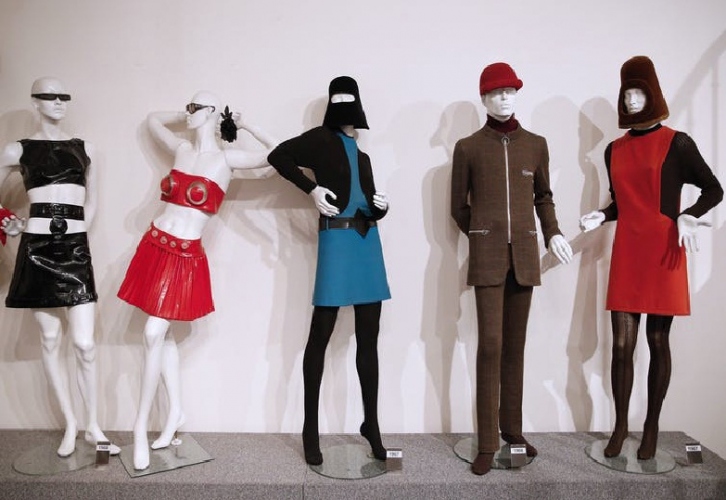Masks have emerged as unlikely fashion heroes as the Covid pandemic has developed. For thousands of years, however, masks have played an important role in conveying style, spirituality and culture. As vizards, face gloves, window hoods… here are some of the highlights (and lowlights) of masks as fashion items

As the Covidpandemic has developed, masks have shown how brevity and style can combine to protect the wearer, offsetting the fear the sight of a respiratory or surgical mask usually inspires.
Every conceivable colour and pattern seems to have become available, from facehuggers to Darth Vader to bejewelled bridal numbers.
Yet, masks remain fundamentally unnerving. Here are some of the highlights (and lowlights) of masks as fashion items.
Masquerade and desire
Venice has long been associated with masks, thanks to its history of carnival and masquerade. Their theatrical nature might lead to an assumption masks were always worn to deceive or seduce. Travellers expecting a masked amoral free-for-all in the early 18th century were surprised at how “innocent” the accessory really was in everyday life.
When worn at a masquerade, masks encouraged “safe” contact between the sexes – bringing them close enough to mingle but maintaining the social distance between strangers that etiquette required. In this scenario, masks also encouraged a kind of egalitarianism by allowing people of disparate social classes to mix – a freedom never allowed in normal social gatherings.
Charming possibilities
“A mask tells us more than a face”, wrote Oscar Wilde in his 1891 dialogue Intentions, yet by the 19th century the mask as fashion accessory was démodé. Masks were generally only mentioned in newspapers and fashion magazines when referring to fancy dress and masked balls, which still took place in the homes of the wealthy.
Although masks were no longer recommended for maintaining a pale complexion, women’s faces were still covered by veiling in certain situations: including, for the first time, weddings.
Veils and visors
The advent of the automobile in the early 20th century brought a whole new fashion range into the public arena. Motorists needed protection from weather, dust and fumes, so accessories had to be practical. For women, protection took the fashionable form of coats and face coverings.
Veils and hoods were wrapped around stylish large hats of the day, and fastened under the chin so that the entire face was safely covered.
Advertisements in the early 1920s describe a “complete face mask” for drivers – ostensibly men as the accessory “buttoned to the cap and [is] equipped with an adjustable eye shield against glaring headlights”.
A design for women in 1907 was described as a “window hood”, which completely engulfed the hat beneath and closed with a drawstring around the neck. It had a gauze “window” for the eyes and another smaller opening at the mouth.
By the swinging 1960s, the cultural and sartorial landscape couldn’t have been more different – and yet, masks made an unlikely appearance in “space age” fashion championed by designers such as André Courrèges and Pierre Cardin. Metallic mini dresses and one-piece suits were topped with “space helmets” that left an opening for the entire face or eyes.
More commonly adopted were plastic visors worn separately or as part of a hat, sometimes covering forehead to chin and taking on the appearance of a welders’ shield – or indeed, the face shields worn by health workers today.
Sunglasses, a kind of mask in their own right, were taken to the extreme by Courrèges with his infamous solid white shades with only a slit for light.
Pandemic times
Discussions during the 1918-19 Spanish flu pandemic around whether masks would be a fad, how long they would be required, and how to create your own at home, seem eerily prescient now.
In Australia, entertainer Todd McKenney launched an online marketplace for costume designers to make and sell one-of-a-kind masks directly to the public.
Face masks don’t have to be created by artists, designers or couture fashion houses to make them appealing. But a look through our fashion history shows that ingenuity and humanity have long influenced our face wear – whether for the purposes of allure, space travel or pandemic protection.
Silenced by the vizard
One of the most bizarre accessories in 16th-century fashion was the vizard, an oval-shaped mask made from black velvet worn by women to protect their skin whilst travelling.
In an age where unblemished skin was a sign of gentility, European women took pains to avoid sunburn or significant sun tan. Two holes were cut for the eyes, sometimes fitted with glass, and an indentation was created to accommodate the nose. Disturbingly, they did not always have an opening for the mouth.
To hold the mask in place, wearers gripped a bead or button between their teeth, prohibiting speech. To the contemporary feminist, the mask raises associations with the scold’s bridle: a method of torture and public humiliation for gossiping women and suspected witches.